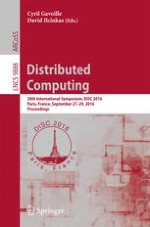2016 | OriginalPaper | Buchkapitel
Information Spreading in Dynamic Networks Under Oblivious Adversaries
verfasst von : John Augustine, Chen Avin, Mehraneh Liaee, Gopal Pandurangan, Rajmohan Rajaraman
Erschienen in: Distributed Computing
Verlag: Springer Berlin Heidelberg
Aktivieren Sie unsere intelligente Suche, um passende Fachinhalte oder Patente zu finden.
Wählen Sie Textabschnitte aus um mit Künstlicher Intelligenz passenden Patente zu finden. powered by
Markieren Sie Textabschnitte, um KI-gestützt weitere passende Inhalte zu finden. powered by
